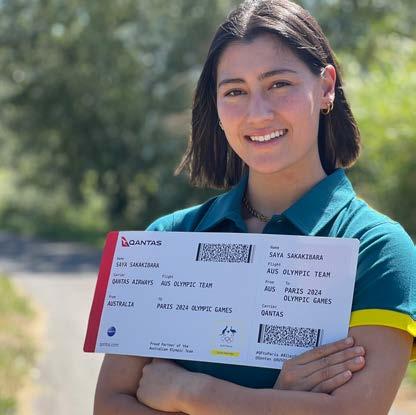




Tickets $40 - $15 | BOOKINGS via Humanitix site: ‘ABDIEL & NEWMAN | p: 0408422427 e: inspiremusica

A FREE CONCERT SERIES donations appreciated SCAN TO BOOK NOW OR GO TO HUMANITIX MUSIC & TEA WOLLONGONG ART GALLERY



MerrigongX season kicks off at IPAC

Local theatre-maker and singersongwriter Joshua Hinton has all the ingredients for a fresh debut with A Place in the Sultan’s Kitchen or How to Make the Perfect One-Pot Chicken Curry, which opened at IPAC on Thursday night.
Join Josh as he delves into childhood memories and family folklore, as well as make local theatre
history by cooking live on stage at the Illawarra Performing Arts Centre (IPAC). Afterwards, he’ll share his onepot chicken curry with the audience.
“Food, in particular, has always been my great connection to culture,” Josh says. “It’s kind of what the story is about – my search for belonging stems from food.”
Read the full story
Calvin Abdiel piano & Cedar Newman violin
Sensational Australian pianist, Calvin Abdiel is in Wollongong with Cedar Newman for one night only - we plan to make it special.
Doors open at 6:30 pm and there will be a drink and nibbles to savor before settling in for a night of lyrical beauty and drama at 7pm.
Together they perform Franz Schubert’s ‘Grand Duo’ and Richard Strauss’s dramatic Violin Sonata.
Friday, 9 August from 6:30pm - 9pm at Wollongong Art Gallery. Click here to book tickets via Humanitix


11 August
WAWAN hosts
Don’t Nuke the Future event in Thirroul
9-11 August
Coastal Reflections CSA exhibition
16 August
‘Anytime’ MTB film screening
16 August The Gruffalo
17 August Illawarra Family History and Heritage Fair
21 August Railway Sessions – Open Mic

1 Sept Fancy Women’s Bike Ride
Sept
5-15 Sept The Mousetrap
20-22 Sept
Folk by the Sea
Click here for more events
By Zachary Houtenville

“The mural is amazing. PCYC loves Jack and loves the work he does.”
– Gina Holland, senior activity officer at PCYC Bulli
Bullilocal Jack Miller Hendry is a youth worker but his true passion is street art.
Accompanied by his trusty Kelpie, Ozzie, Jack has brought his passion for art to Wollongong, aiming to introduce a new generation of style.
“I don’t want to work at a job where my talents are wasted,” Jack said. “I’m trying to provoke thought when people look at my murals.”
Jack grew up south of Wollongong in Moruya; his mum has been collecting his drawings since he was two. Art runs in the family – his mum owns a cleaning business but is also a landscape painter and a graphic designer. “It’s just kind of in the blood,” Jack said.
Jack has dyslexia, which he believes influenced his artistic journey, guiding him towards art. The unique way he perceives patterns enhances his creativity, leading to captivating and original work.
On leaving school, Jack moved to Lismore to attend Southern Cross University, where he studied visual arts. It was there that he truly embraced street art, learning how to spray paint and taking part in a warehouse project where he and friends covered the place in art murals. He moved to Wollongong in 2020. Jack now plays a role in keeping
Bulli beautiful with his murals, which he believes help deter young vandals.
“Artistically, there’s just not that much to do, they’re sick of the blank wall,” Jack said. “If you paint something nice on it rather than just covering it up, people will be less likely to vandalise it.”
At PCYC Bulli, a charity dedicated to helping local youth, Jack was given free rein and over three days he created an eye-catching sport-inspired design on their building.
“The mural is amazing”, says Gina Holland, senior activity officer at PCYC Bulli. “PCYC loves Jack and loves the work he does.”
After seeing his work at PCYC Bulli, I met Jack at the train station for a tour taking in his local work. These include a series of fence murals showcasing various styles, from cartoons to American traditional murals. Jack’s work, featuring story scenes, pop-culture icons, and depictions of his dog, has brightened up the neighbourhood.
For now, Jack will keep painting as much as he can, in the hope that one day he can make it a full-time career.
“I want to get people to appreciate the art and coat Wollongong as much as I can,” Jack said.
To commission a mural, contact Jack via Facebook or Instagram.
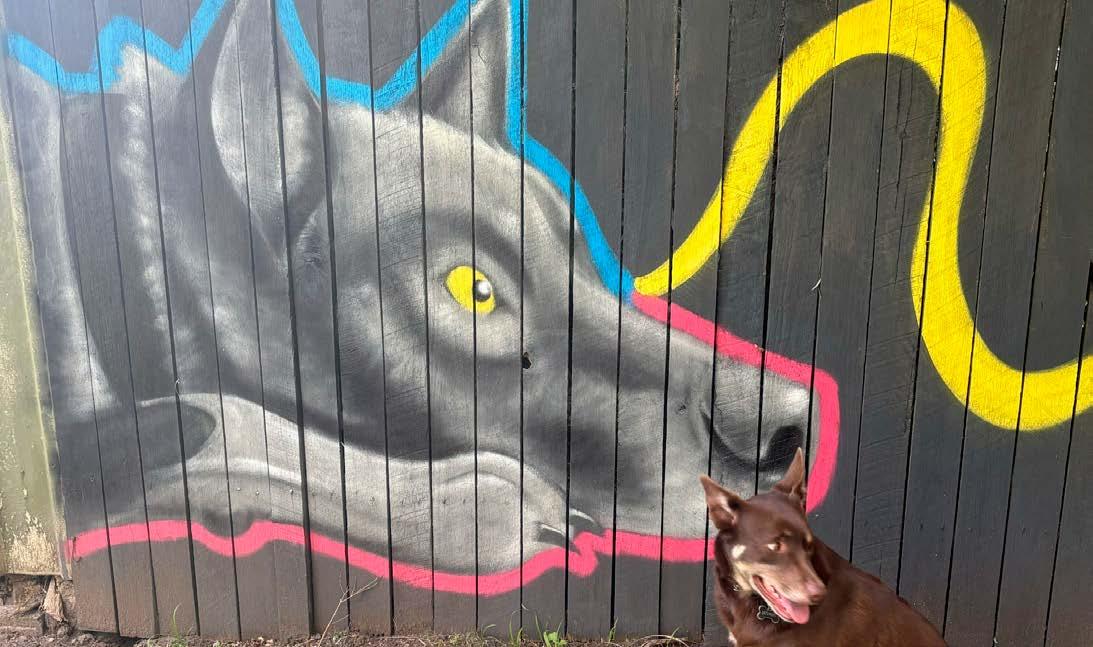

By Zachary Houtenville

Olympic gold medallist Saya Sakakibara honed her racing skills at Southlake Illawarra BMX Club near Albion Park.
The 24-year-old elite BMX athlete – who triumphed on the track in Paris last weekend – grew up in Helensburgh and spent many of her formative years training at the club near Albion Park.
Southlake Illawarra BMX Club’s Facebook page
“Look, she’s phenomenal,” said Marcos Baez, the president of Southlake Illawarra BMX club.
“When she’s on her day, she’s the best in the world.”
Founded in the early 1980s, Southlake Illawarra is one of NSW’s oldest BMX clubs. It is known for its community,
family focus and for helping develop some great talent over the years.
Saya and her older brother, Kai, became members in 2007.
Southlake Illawarra BMX Club was instrumental in the Sakakibara siblings’ development as BMX athletes.
Saya and Kai went on to achieve world BMX success and were both tipped to impress at the 2020 Tokyo Olympics (eventually held in 2021 due to delays caused by the Covid-19 pandemic).
However, in February 2020, Kai, 23 years old at the time, crashed in his opening-round heat of the UCI BMX World Cup event at Bathurst and suffered a traumatic brain injury that ended his BMX career. When Saya competed in Paris, pedalling her way into Australian
sporting history, she wore Kai’s old race number, 77, in honour of her brother.
Southlake Illawarra BMX Club is dedicated to providing the best for its riders, demonstrated by a $200,000 investment in track upgrades, including a new start gate, remodelling, resurfacing, and a new sprint lane. The club has also bought essential equipment, such as bikes, full-face helmets and gloves, to make the sport more accessible for new riders.
If you’ve been inspired by the Sakakibara spirit and want to try the sport, all you need is a long-sleeved shirt, pants and enclosed shoes. Riders do need a cycling licence, but the club offers a four-week free trial for all newcomers.
“You can basically try the sport without spending a cent,” Marcos said.
“You just need a good attitude and are ready to have fun.”
While many kids gravitate towards team sports, BMX offers an alternative for those who thrive in individual sports, including kids with anxiety or ADHD, Marcos said. For adults, BMX is a chance to get fit and engage in a challenging, non-mainstream sport that families can enjoy together.
“You don’t get a lot of sports that you can have a kid ride with their mum or dad, or both,” Marcos said.
“It’s hard, it’s challenging and it’s one of those sports I don’t think it ever really
gets any easier.”
The club is also keen to help competitors. It provides practice sessions, club racing and experienced coaching, including by multiple Australian champion Leanna Curtis. The club has also linked up with the Illawarra Academy of Sports (IAS) and it guides athletes, such as Blake Mete, to compete in state-level events.
“I’m heavily involved in the sport, I officiate at large events,” Marcos said. “We just stay involved and informed with what’s going on in the BMX world, which helps any potential.”
If you would like to get involved, check out Southlake Illawarra BMX Club’s Facebook page.
Saya stamps issued After her triumphant race in Paris, Helensburgh BMX athlete Saya Sakakibara has been recognised with an Australian Olympic stamp.
Australia Post is honouring Australian gold medallists by featuring a photo from their Olympic medal ceremony on a series of collectable $1.50 stamps.

A set of 10 costs $15 and can be ordered now via Australia Post’s website.
Saya stamps will be available in store at participating post offices.

“You can basically try the sport without spending a cent. You just need a good attitude and are ready to have fun.”
– Marcos Baez, the president of Southlake Illawarra BMX club
By Zachary Houtenville

“We teach them how to better themselves.
Parents say to me: ‘I don’t know what you’re doing, but their grades are better.”
– Dominic Lavelle, Reflex Martial Arts Centre co-owner
Wollongong’s Dominic Lavelle has been teaching kids and adults the positive power of discipline through martial arts training for almost 30 years.
Dominic is head instructor at Reflex Martial Arts Centre and owns the well-regarded combat sports hub with his wife, Rosanna.
Reflex Martial Arts Centre runs classes six days a week, including boxing, Muay Thai (Thai kickboxing), Brazilian Jiu Jitsu (BJJ) and Cacoy Doce Pares Eskrima (Filipino stick-fighting). People of all ages and skill levels are welcome.
For those who aren’t interested in competing, Reflex offers the chance to try different martial arts.
“If they have patience, we’re happy to help anyone,” said Dominic Lavelle, head instructor and owner of Reflex Martial Arts Centre.
Dominic has been training in martial arts since he was 14 when, with some urging from his mum, he joined his first Taekwondo class. By 18, he had earned his black belt. Since then, he has achieved several black belts in different martial arts styles, including a fourth degree black belt in Cacoy Doce Pares Eskrima, a first degree black belt in Brazilian Jiu Jitsu, first degree black belt in Muay Thai and more.
In 1996, Dominic fulfilled his dream and, with his wife, Rosanna, he opened
the Reflex Martial Arts Centre.
Rosanna has a long, proud history in combat sports, having started her training at age 17 under Dom. Initially drawn to the fitness benefits of martial arts, she went on to a 10-year professional fighting career.
She achieved several milestones, including becoming the first woman black belt in combative kickboxing in 1998, NSW Black Belt Champion in 1998 and 1999, and Australian Black Belt Champion in 1998. Rosanna also holds a seventh degree black belt in Combative Martial Arts, a first degree black belt in Cacoy Doce Pares (Filipino stickfighting) and other accolades.
Dominic, Rosanna and their team have created an environment at Reflex in which people can improve in all areas – combat, fitness, wellbeing, personal development – and staff instil discipline and respect in younger athletes.
“We teach them how to better themselves,” Dominic said.“Parents say to me: ‘I don’t know what you’re doing, but their grades are better.’ This is the place to come for all of that.”
For women, combat sports are a chance to learn self-defence. Rosanna, who teaches self-defence at selected schools and universities, said the classes give people the “ability to walk with confidence on the street”.


By Zachary Houtenville

“Everyone deserves to be able to enjoy water and the joy that it brings.”
– Greg Crawford, general manager of McKeon’s Swim School
McKeon’s Swim School
TheAustralian women’s swim team has been phenomenal at this year’s Paris 2024 Games, with swimmers Ariarne Titmus, Mollie O’Callaghan, and Kaylee McKeown all taking home gold in their events, but the Illawarra region is justifiably most proud of its very own, Emma McKeon.
Since her debut at the 2016 Rio Games, Emma has won 12 Olympic medals, including six gold. In Paris this week, she was part of the Women’s 4x100m freestyle relay team taking home gold, making her the most decorated Olympian in Australian history.
For the many locals inspired by Emma’s career, her family’s swim school offers Wollongong residents a chance to enjoy the water just as much as they do.
“Emma has had amazing success as a swimmer,” said Greg Crawford, general manager of McKeon’s Swim School.
“We couldn’t be prouder of her.”
Emma’s parents, Ron and Susie, opened McKeon’s Swim School in 1991 after leaving their day jobs. They expanded to a second location in 1996 and moved the school to its current Unanderra site in 2005. The school has employed more than 100 staff and taught thousands of people in the Illawarra.
“It’s about sharing the love of water,” Greg said.
“We understand that not every person
who comes to the pool is going to turn into an Olympian.
“In the environment and location where we live, it’s an Australian lifestyle.”
With another facility in Towradgi, the school has programs for all ages. Whether it is helping a child or adult swim up to 400 metres or a toddler swim to the side of the pool, the aim is to allow everyone to progress at their own pace, said Natasha Sturges, a McKeon’s swim instructor.
The school also runs a program for people from non-English-speaking backgrounds, helping them acquire a lifelong skill and enjoy the water.
“Everyone deserves to be able to enjoy water and the joy that it brings,” Greg said. “Being able to swim is fundamental to safely enjoy water activities.”
Various classes support this mindset, from aqua aerobics to lessons designed to simply teach someone how to swim. For infants and young children, it’s about familiarising them with the water and creating the bond early on.
The school offers a comprehensive program for competitive swimmers, utilising top-quality coaches and facilities, including the University of Wollongong, to support swimmers’ journeys as far as they aspire to go.
The school also provides valuable employment opportunities.
By Emma Rooksby of Growing Illawarra Natives
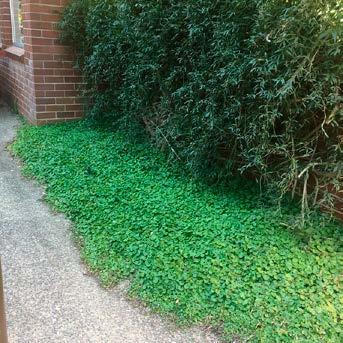
“It’s used as a lawn grass or ground cover in shady and part-shade areas.”
– Emma Rooksby
Kidney Weed, or Dichondra repens, is a well-known native plant across Australia. I’ve seen it for sale in nurseries in Perth, Canberra, Sydney and Wollongong. This attests to Dichondra’s versatility and ease of cultivation, and it’s used as a lawn grass or ground cover in shady and part-shade areas. It can sometimes even hold its own in sunny spots along the escarpment, as long as the soil is moist.
It may be tempting to take this plant for granted, but it’s an important element of local ecosystems, and has its own appeal if you look closely enough.
Pictured above left is typical view of Kidney Weed, used as a ground cover. It provides dense cover, is a pleasant shade of mid-green, and is otherwise unexceptionable. Easy to overlook in other words. Image by Emma Rooksby.
In natural areas, Kidney Weed doesn’t generally dominate to this extent, but tends to occur mixed in with a wide range of other ground covers, ferns, climbers and saplings.
It grows in a range of situations, including coastal areas, the coastal plain, and along the escarpment, and you’re likely to see it on any bushwalk you’d care to do.
By Ian Pepper of Ray White Helensburgh
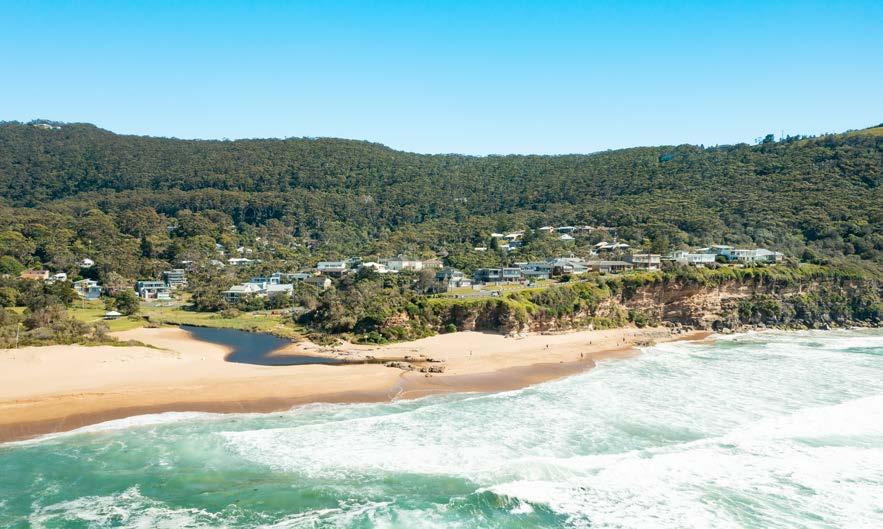
Looked at up close, the kidney-shaped leaves and tiny, pretty green flowers of Kidney Weed are absolutely gorgeous. The seeds are also important to local fauna, and are eaten by animals such as the Pacific Black Duck. Image below by Elena Martinez.
Look out for this little ground cover on your wanders, and check out what other species are growing with it. You might see it intertwined with Prickly Rasp Fern (Doodia aspera), Scurvy Weed (Commelina cyanea), Bearded Tylophora (Vincetoxicum barbatum) or Basket Grass (Oplismenus aemulus) among many other species.
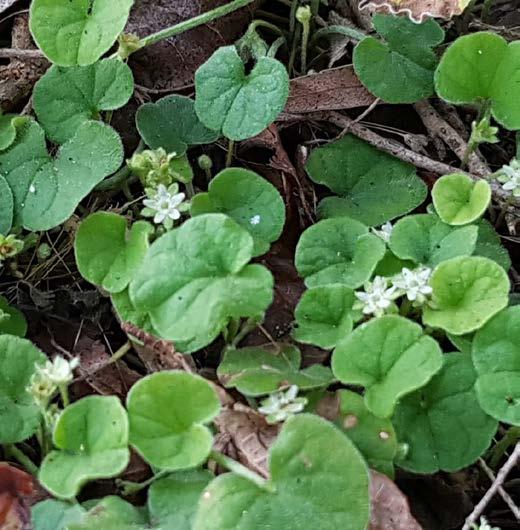
Interest rates remained on hold again this week, following the Reserve Bank of Australia (RBA) meeting. It’s been a volatile month for rate forecasts, only a month ago the market was forecasting a rate rise today. However, with reasonable inflation data coming out last week, it was expected by most economists and the market that the RBA would keep the status quo.
This is good news for mortgage holders and the real estate market. The talk of another rate rise was holding buyers back and curbing their optimism. Hopefully this can be cast aside now and the market have some confidence that the next rate movement is down. This could be in late 2024 and/or early 2025.


By Amanda De George
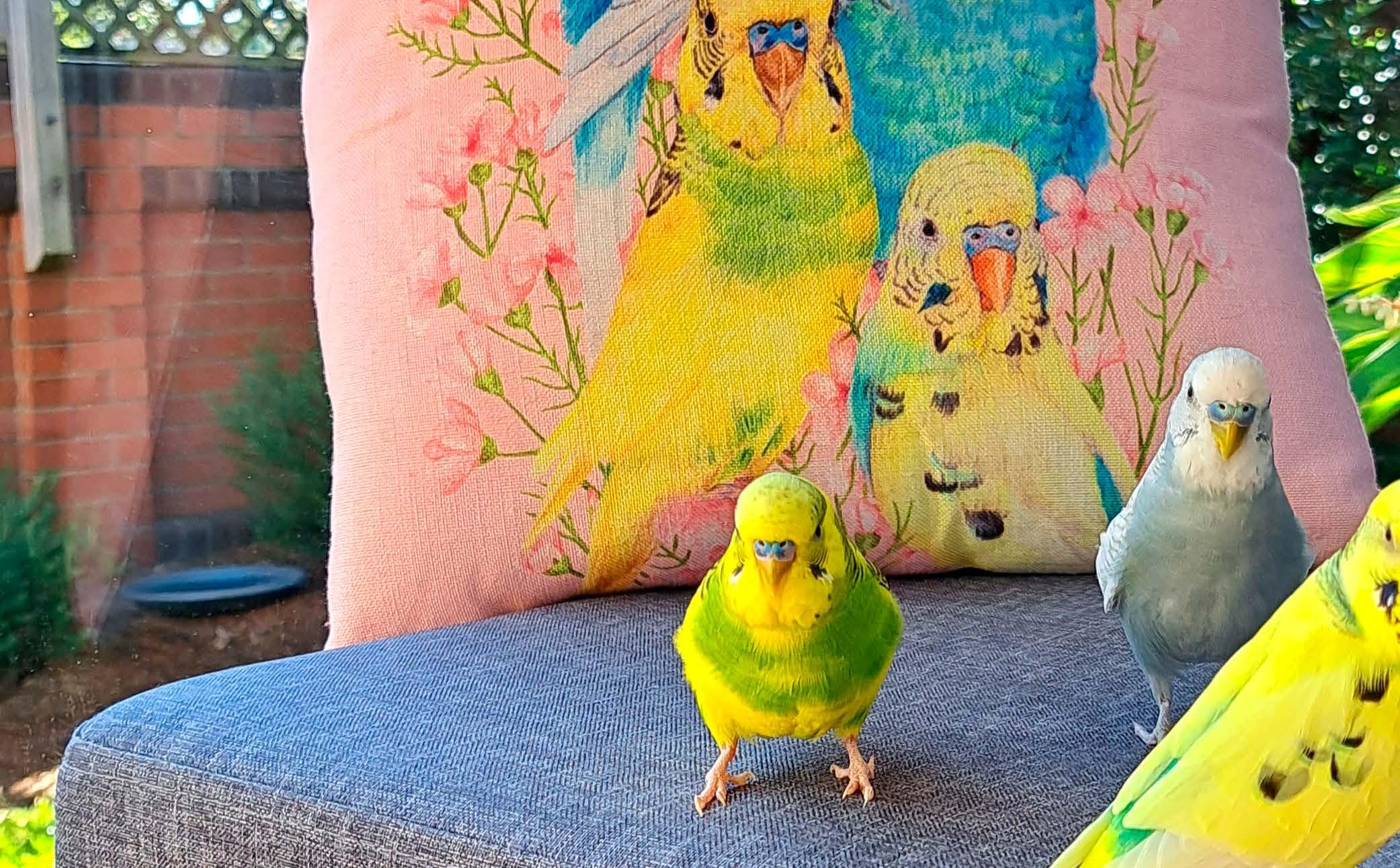
Illawarra pencil artist Kayla Reay has found there’s loads of benefits to running her own small business. There’s the sense of community with fellow creatives, being able to chat to and share passions with her customers, and also being able to keep a close eye on her three co-workers.
As the boss she’s worked hard to foster great relationships, giving all three free rein of the house while she’s working, providing them with native plants to enjoy and not minding the little bit of chaos they bring as they do laps around the place. I should probably point out that I’m referring to her much-loved sources of inspiration, budgies Barley, Farro and Buckwheat.
“They live very full and joyful lives and that’s a constant source of inspiration for my artworks,” Kayla said.
Kayla is a self-described avid bird nerd and the tagline for her business is “art for the bird lover, by a bird lover”. But it’s more than that. It’s also a love letter to the natural beauty of the local area.
“I grew up in Wollongong as a very outdoorsy person and have always found nature to be a source of inspiration. It’s hard for it not to, here in Wollongong: with the gorgeous mountains to the west, the ocean to the east and an array of vibrant birdlife speckled between,” she said.
“My art is driven by a desire to encourage connection and stories through the birds we hold a specific love for.”
While some of us were making sourdough and day drinking, Kayla used the Covid lockdowns to launch her

“IMy art is driven by a desire to encourage connection and stories through the birds we hold a specific love for.”
– Kayla Reay
business.
“I’d just graduated Uni and lost shifts at my face-to-face retail job so I suddenly had a lot of time on my hands. After a lifetime of contemplating pursuing art as a means of income, I threw myself into it!” she said.
“I genuinely don’t think I would have taken that terrifying leap if not for the ‘well, what else do I have going on?’ mindset that lockdown put a lot of us into.”
She started with ‘Bird Bouquets’, a series of pencil artworks featuring iconic Aussie birds perched amongst vibrant native Australian flowers. I’ve got a soft spot for both and, trust me, putting the fan-favourite ‘bin chicken’ aka Australian White Ibis atop of a bouquet of proteas and banksia is genius. And don’t even get me started on the Tawny Frogmouth! The collection is still growing and is featured as part of her 2025 calendar (available for pre-order with some cheeky gifts thrown in here).
“I’d describe my art style as realism,” Kayla explained, “but I can go very dramatic with my use of colour in my attempt to highlight just how vibrant, joyful and unique our local birdlife is. Sometimes I honestly feel that nature is
the true artist, and I’m simply drawing what I see.”
On working with pencils, Kayla said, “They allow for an insane amount of control and precision. They can be layered but they can also be erased. I’d describe my art style as “realism” so having control over details is really important.”
And while it took a global pandemic for Kayla to launch her business, its success still comes as a bit of a shock.
“I think ‘success’ as a creative is often talked about like it’s a make-believe concept,” she said.
“I won’t deny, it’s certainly not the lifestyle to pursue if you want a consistent and predictable income but that doesn’t mean there’s no success in it at all.
“Even this deep into running my business, I’m still over the moon every time an online order comes through. The thrill of realising that someone wants to hang MY silly little bird drawings on their wall just never gets old.”
Follow Kayla on Facebook, Instagram, shop on her website and find her at Wollongong Makers Markets on November 9 and 10, when you can talk all things bird with her.

By Tyneesha Williams

Watson has committed her career to supporting women in science, technology, engineering and maths (STEM) and entrepreneurship.
A project officer at the LIFT initiative at iAccelerate at the University of Wollongong, Georgia has a background in ecology and Antarctic research, and says that the field continues to be dominated by patriarchal attitudes.
“There are still cultural issues around accepting people who are women, non-binary, gender diverse, culturally diverse, or those with different sexualities, Georgia says.
“We need diverse voices in climate solutions, and when this job came up at iAccelerate, it was a really good fit for me and what I wanted to shift toward.”
Kal Glanznig, Kylie Flament, Georgia Watson and Penny Towney at June’s Rising Up film night.
Photo: Tyneesha Williams
Graduating from University of Wollongong with a Bachelor of Science with a major in biology, Georgia says she didn’t find her stride until her second year of studies, when she switched from human biology to ecology.
“I was first interested in science because of things like David Attenborough documentaries. Steve Irwin was my hero growing up,” Georgia says. “It wasn’t until later in life that I realised I didn’t have any female role models growing up. It was literally all the men of these adventure shows.
“It took me a really long time to see myself in the field.
“When I got to meet people in ecology and biology who were women from diverse backgrounds, I thought, ‘Oh,
anybody could do this’. It’s not just white men on the telly.”
Georgia is a part of Homeward Bound, a women in STEM leadership initiative with a focus on climate action and sustainability. She will join a voyage to Antarctica in January 2025 with her cohort of 88 women and gender-diverse individuals from 26 nations.
“We all have a different way of looking at the world,” Georgia says.
“We all have different local communities and local solutions with expertise across science, technology, engineering, maths, medicine, and creatives are starting to come into the mix as well.
“It’s about coming together and whatever you need, you can ask of the network. It’s kind of combatting the boys’ club in that it’s a network of people trained in leadership who value compassion and kindness and are working towards a shared vision.”
This cohort’s voyage will be the last to go to Antarctica for Homeward Bound. The alumni and current cohort have decided as a collective that the region is changing too rapidly to justify continued trips.
Georgia and her cohort are rallying the Illawarra community to raise funds for Homeward Bounders through initiatives such as a screening of Rising Up at UOW Science Space in June.
“One person said that the cost of undertaking the leadership program and the voyage is 200 times one person’s
salary where she lives,” Georgia says.
In 2023, the Australian Government reported that only 15% of STEMqualified jobs are held by women. Georgia is helping to increase diversity in the field and create more varied climate solutions in the coming years.
“If you think of a leader, a lot of people think of Steve Jobs types. But when I think of a leader you go to in a crisis… It’s mums. Mums are the leaders that we want in charge,” Georgia says.
“I’m still seeing panels that are all white men. And really, what different perspectives are you going to get from a panel like that?
“Support women who are in positions of power. Support women’s voices and support a variety of voices.”
Georgia emphasises connection as a tool for change and encourages locals to get involved in community initiatives that interest them.
Locals can help reduce waste through organisations like Circular Plastics Illawarra, or connect through groups like Beach Cleanups Illawarra. Georgia also notes the work of Tomorrow Movement and the Australian Youth Climate Coalition (AYCC), which both have local chapters in the Illawarra.
“Whatever you care about, get out and get active, Georgia says.
“It can be off-putting to put yourself in a vulnerable position to talk about big things like climate change, renewable energy, saying no to plastics… but nothing will change without it.”
“It can be off-putting to put yourself in a vulnerable position to talk about big things like climate change, renewable energy, saying no to plastics… but nothing will change without it.”
– Georgia Watson


By Genevieve Swart

“I think what we need is to fundamentally restructure the board of AEMO and the other regulatory agencies”
– Ty Christopher
Last week, Ty Christopher, Director of the Energy Futures Network at the University of Wollongong, explained how, thanks to the people’s rooftop solar revolution, he believes energy regulations are no longer fit for purpose. This week, he calls for structural reform to put consumers before gentailers – that is, generator retailers who own the assets that generate electricity and also sell electricity to businesses and homes.
If old rules no longer apply, what should we do?
The big challenge is we’re talking here about multi-billion dollar companies, in particular, the large retailers and the large gentailers.
There’s three big retailers that dominate the market: AGL, Origin and Energy Australia. They collectively have so much of the market under their control that they can influence the wholesale price of electricity and hence increase what we all pay for our electricity.
People with backgrounds in large energy corporations, including fossil fuel companies and the large grid operators dominate, in their numbers, the board membership of the Australian Energy Market Operator (AEMO). So we have a
situation where the market operator is run by a board, and that board is populated with many people with backgrounds in large energy corporations and fossil fuel companies, and that market operator is expected to control the market and make sure the market is working properly. My question is in whose best interests will they operate the market? I think we can all guess the answer…
Not many people know about this situation – when I say it to people, they’re almost shocked by it. But it has forever been that way.
Indeed, AEMO is funded via fees paid by market participants. So, the big energy companies who use and benefit from the market are the ones paying the market controller to operate the market.
My question again is in whose best interests will they operate the market?
Do we need more transparency in the energy sector?
I think what we need is to fundamentally restructure the board of AEMO and the other regulatory agencies such as the the Australian Energy Market Commission (AEMC) and the Australian Energy Regulator (AER).
Some of these regulators might
present to us one or two token board positions which are there as the customer representative. Well, I say good luck when that comes down to a vote when you are the one customer representative in a room full of board members who come from industry backgrounds.
So I think that the answer for us, as consumers, is quite obvious.
We should basically be replacing the boards of these energy regulators with boards that are majority, not entirely, but majority dominated by representatives who look after our interests as energy consumers, not the interests of the multi-billion-dollar companies that make multi-billion-dollar profits out of charging us for energy and energy services.
Yes, industry representatives should have a voice at the table perhaps, but I really fundamentally ask the question as to whether that voice should be the dominant one, and the one that prevails, or whether us as consumers should have the final say.
So that would be the most immediate change that could be made.
That would be, I think, the best thing to bring down electricity prices and shift the focus in the electricity market onto better use of distributed energy resources (solar, batteries, et cetera) and bring about more democratic access to clean energy – really addressing some of those
structural reforms that are needed in how the energy markets operate.
Who would you put on the boards? What would be the best combination?
I think we could be looking to not-for-profit and social interest bodies that are already out there to place their senior members and their existing board members onto these energy boards as a very good start.
I’m thinking here about representatives from, say, the Salvation Army and Energy Ombudsman. People who are seeing in real time, in their main reason for being, the impacts of energy poverty and the of cost-of-living crisis in families. They would bring that real shared perspective into them saying, ‘Well, now hang on a minute, let’s set some rules up here that operate much better in the interests of all energy consumers and businesses.’
We hear lots of talk about energy market reform, but talk does nothing to structurally address any of the problems that are here, and neither do handouts for electricity bill relief, much needed though they are. Rather than pursuing one-off political sugar rush solutions, or talking about reform, we should instead demand our leaders take positive action to appoint regulatory boards who will operate in our best interests as energy consumers.
By Matthew Derbridge

“Yes, industry representatives should have a voice at the table perhaps, but I really fundamentally ask the question as to whether that voice should be the dominant one.”
– Ty Christopher
Toastmasters will help you get to where you want to go and master the art of public speaking in a supportive and friendly atmosphere.
Toastmasters is beneficial for those looking for an edge in the work place, a presentation, confidence in everyday life and fellowship. And it all began on 1st August 1957 with Wollongong Toastmasters – the first club in Australia!
Our members are very proud to be part of such history. The very first meeting was held at the Grand Hotel, with the group founded by local businessmen.
Wollongong Toastmasters meet fortnightly on a Wednesday evening at the Wollongong Golf Club. Read more.
By Wollongong psychologist Jo Lunn

“We need to actively seek out good news and examples of where things are going right”
“Focus on what we have in common with each other, see the human being in front of us and how we are similar instead of how we are different.”
– Jo Lunn
The last three articles have outlined how our biological, psychological and emotional survival is linked to our connection to other humans. Our physical frailty in comparison to large predators and the complete dependence of human children has made it clear the only way to survive is to depend on each other, work together and find ways to solve problems.
Working together requires us to conform with our tribe’s rules. Our brain’s ‘don’t eat me’ design has meant that we will always overestimate danger, which is a clever survival mechanism. If we overestimate the level of danger, we are far more likely to survive than if we underestimate danger.
Some corporations, movements, political parties or politicians, media companies and influencers target our ‘don’t eat me’ brains and need to connect to make profits and get power.
Hearing about a ‘threat’ and an ‘us and them’ story, intelligent, well-intentioned, educated people can get sucked into groupthink. Ironically, groupthink arises from the need to feel safe and connected, but these universal desires can be manipulated to build fear and ‘threat’. The mantra of groupthink is ‘you are with either us or you are against us’. If group members raise questions or concerns, they risk being ignored, ridiculed or excluded. Then connection to the group becomes potentially
precarious – we can only stay in the group if we agree with everything they do and say, increasing our anxiety which increases our dependence which increases our anxiety and so on.
Recently an Australian politician asked our local community to use their vote as a ‘bullet’ to say goodbye to the prime minister, weeks after an American presidential candidate was shot. Everyone, regardless of how we vote, can see that actual or metaphorical threats to politicians undermine the democratic process.
We have media news companies knowingly lie to us so they can sell premium advertising space, corporations ignoring moral, ethical and often legal rules in the name of profit and it seems to be generally accepted that many politicians can ignore facts, slander reputable institutions or experts, openly lie and try and divide communities, in a grab for power. A worldwide pandemic – with people losing loved ones, businesses and jobs – war and horror in Europe and dire environmental news has rocked our understanding and feelings of safety in the world. The cost of living has skyrocketed. This is all in addition to our usual life pressures.
Add extra distress – divorce, sickness or death of a loved one – and it may feel like we are living in a soap opera with drama after drama enveloping us. This is a perfect storm of pressure on our mental health as our ‘don’t eat me’ brain is almost on a swivel, frantically spinning in all directions, looking for the next threat. Our bodies’ stress response can lead us to feel like we are going to jump out of our skin or the opposite, like a deflated basketball with no bounce.
All our energy goes toward just getting through the day. With continued high stress, we can slide further into symptoms of depression and anxiety. Losing interest in people or activities that used to bring us joy, increasing sensations of emptiness and feelings of meaningless, increasing our alcohol or substance use/online shopping/
gambling/gaming and mindless activities like endless scrolling on our devices or binge-watching TV, we stop caring about things that mattered to us or other people as everything becomes too much.
All these responses, although normal for an overwhelmed ‘don’t eat me’ brain, go against our biological, psychological and emotional need to genuinely connect and feel safe with other humans.
Most importantly, as life becomes overwhelming, our ability to engage, think flexibly, learn, reason and make decisions is significantly impaired. Our ‘don’t eat me’ brains are too busy responding to perceived threats, so we have less mental capacity to be interested in our world and to explore new ideas and connections.
For some, these pressures result in a switch from conformity to groupthink as our fear, anxiety and anger rise and our trust in the systems around us plummet. We seek out people or groups who seem to know the answers, know the truth and have done the research for us. For others, apathy and disinterest is the way they manage – the world is too much, too broken and too overwhelming. They manage their distress by blocking it out and disengaging, feeling there is no way they can make a difference, so why waste the energy. Others manage by anxiously keeping things ‘light’, nodding along to opinions they don’t agree with to avoid conflict.
Whether it is divisive ‘us and them’ groupthink, avoidance or outright disengagement, the result is we stop holding people, political parties, the media and corporations accountable. We also lose our superpower of tapping into the incredible human capacity for flexible, diverse thinking and working together to solve problems.
So, what can we do?
1. Take care of ourselves. By focusing on what we can control, living in line with our values and having a real connection with others, we can reduce our fear, sadness and anxiety.
Click here to find 4 ways to act.
Click to read the full story on the Flame’s website
By Zachary Houtenville

Driven by a passion for LEGO, Graham Draper leads Gonglug and Playwell Events, creating outstanding displays and raising money for charities through their LEGO shows.
Gonglug is an Illawarra-based charity organisation founded in 2019 by a group of local adult LEGO enthusiasts. They collaborate with charities and host four shows a year, including April’s Annual Illawarra Brick Show.
Over eight years, that event has raised $200,000 – two years under the Sydney LEGO group and six years under Gonglug – with help from KidsWish.
KidsWish stakeholder engagement and fundraiser manager Emily Wright provides volunteers and promotional assistance, and Kids Wish receives 100% of the profits. This year’s show helped to raise $43,000.
“We get the money, we buy cash donations, we buy LEGOs,” said Graham, the founder of Gonglug and Playwell Events.
“We put it back into the local economy and that’s something I’m really passionate about.”
The Gonglug shows give people a chance to fully immerse themselves in the world of LEGO, including LEGO play tables, LEGO mosaic building and LEGO R/C car racing activities. At 2024’s Illawarra Brick Show, they hosted a celebrity brick battle, where local sporting celebrities, a junior LEGO builder and a LEGO master teamed up to see who could build the best project.
Along with his registered business, Playwell Events – a touring LEGO exhibit around NSW and Victoria that he founded in 2022 – Graham has turned his passion into a career.
“During Covid, I got to build a lot of LEGOs and I thought, ‘I’m gonna make this work for me’,” Graham said.
“So, it’s been two and a half years now and I went full-time with it.”
Like many LEGO lovers, Graham’s passion began in childhood. In 2013, his
wife gave him an Architecture LEGO set featuring iconic buildings from around the world. Realising he wanted to build more of these, Graham joined the LEGO community, discovering a shared passion that ultimately inspired his career.
When visiting Graham’s office, I saw impressive LEGO models of Ghostbusters and a building made by someone in Germany. Intrigued, I asked about his crowning achievement. That’s when he showed me a photo of his model of the Interlace Building, an apartment complex in Singapore, that took him 12 months and about 85,000 LEGO pieces to make.
Graham no longer has the time to dedicate 12 months to a single project, opting for smaller pieces instead. However, just like his larger projects, these smaller creations require a unique focus and precision to perfect.
“There is a lot of repetition, they’re not always enjoyable but the end result is quite nice,” Graham said.
Graham’s LEGO skills have not gone unnoticed: he was invited to join the background team to work on the TV series LEGO Masters Australia, a show in which contestants compete in teams to build LEGO projects. As part of the background team, Graham helped build the many props for the show, including the famous Hero pieces.
“You’re not allowed to go on the show if you work on the show and I had no hesitation signing that,” said Graham.
“I love working behind the show, working alongside other really good builders.
“These are guys that I look up to, I learn a lot of different stuff and made a lot of contacts.”
Playwell Events has upcoming exhibitions scheduled in various locations, including Moss Vale on August 10, with more to follow.
For Wollongong locals, Gonglug will host its annual Christmas Fundraiser from October 7-10.
This year’s event will be at Fairy Meadow’s Fraternity Club, which has generously offered the venue for free. Money raised will go to the Supported Accommodation and Homelessness Services Shoalhaven Illawarra (SAHSSI), as it has for the past three years.
“That’s my passion,” Graham said.
“My business is my business, I’m happy doing what I do there, but I’m really trying to build these local shows.”
For more information on Gonglug and Playwell Events, as well as updates on upcoming shows, visit their Facebook pages.

“I love working behind the show, working alongside other really good builders. These are guys that I look up to, I learn a lot of different stuff and made a lot of contacts.”
– Graham Draper works behind the scenes at LEGO Masters

